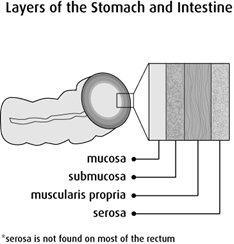Stages of gastrointestinal neuroendocrine tumours (GI NETs)
Many gastrointestinal neuroendocrine tumours (GI NETs) are staged differently than other types of GI cancer. These include NETs of the:
- stomach
- small intestine and
ampulla of Vater - colon and rectum (also called the large intestine)
appendix (not part of the GI tract but often grouped with GI organs)
The staging system used for GI NETs is the TNM system. For GI NETs there are 4 stages. Often the stages 1 to 4 are written as the Roman numerals I, II, III and IV. Generally, the higher the stage number, the more the cancer has spread. Talk to your doctor if you have questions about staging.
Find out more about staging cancer.
Stages for NETs of the stomach, small intestine, colon and rectum
The stomach, small intestine, colon and rectum are made up of different layers of tissues. The stage often depends on which layer the tumour has grown into.

Only well-differentiated NETs and well-differentiated neuroendocrine carcinomas of the stomach, small intestine, ampulla of Vater, colon and rectum use the following stages.
Stage 1
The tumour has grown into the connective tissue layer (lamina propria) within the inner lining (mucosa) of the stomach, small intestine, colon or rectum, or it has grown into the layer surrounding the inner lining (submucosa). Tumours of the ampulla are only in the ampulla.
For tumours in the stomach, small intestine or ampulla, the tumour is 1 cm or smaller. For tumours in the colon or rectum, the tumour is 2 cm or smaller.
Stage 2
The tumour has grown into layers of tissue surrounding the mucosa, such as the thick layer of muscle (muscularis propria) or the area before the outer layer (subserosa). Or the tumour has grown into nearby tissues surrounding the small intestine, ampulla, colon or rectum.
For tumours in the stomach, small intestine or ampulla, the tumour may be larger than 1 cm. For tumours in the colon or rectum, the tumour may be larger than 2 cm.
Stage 3
The tumour has grown into the membrane that covers and supports most of the organs in the
abdomen (called the visceral
Stage 4
The cancer has spread to other parts of the body (called distant metastasis), such as to the liver or lungs. This is also called metastatic cancer.
Stages for NETs of the appendix
NETs or neuroendocrine carcinomas of the appendix are staged using the following.
Stage 1
The tumour is 2 cm or smaller.
Stage 2
The tumour is larger than 2 cm. Or the tumour has grown into the outer layer of the appendixor the tissue that connects the appendix to the ileum (called the mesoappendix).
Stage 3
The tumour has grown into nearby organs or structures, such as the wall of the abdomen or muscle. Or the cancer has spread to nearby lymph nodes.
Stage 4
The cancer has spread to other parts of the body farther from the appendix.
Recurrent GI NETs
A recurrent GI NET means that the cancer has come back after it has been treated. If it comes back in the same place that the cancer first started, it’s called local recurrence. If it comes back in tissues or lymph nodes close to where it first started, it’s called regional recurrence. It can also recur in another part of the body. This is called distant metastasis or distant recurrence.
